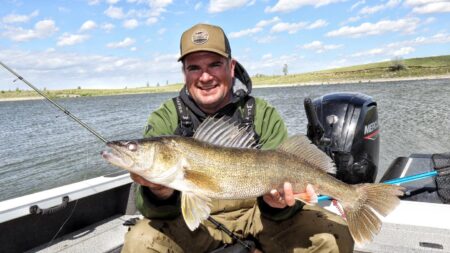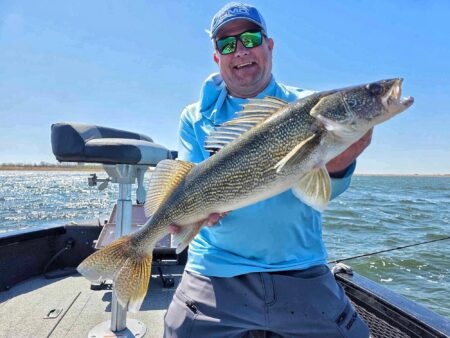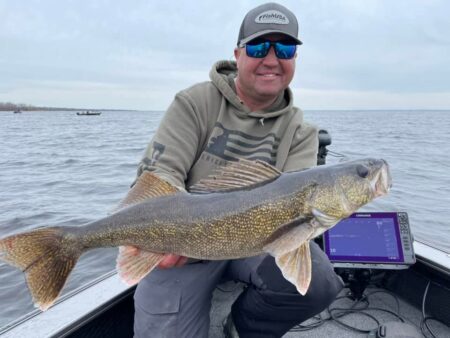Ice fishing participation has grown significantly over the past decade thanks to products that make it easier to locate fish, catch fish, and get out into the cold. And COVID…let’s not forget that interesting time… Yes, ice fishing can be a great way to “social distance.” Anyway, the biggest factor to a good hardwater experience is learning how to best stay warm and comfortable while ice fishing—and today’s high-tech products have made ice fishing a heck of a lot more fun than the days many of us ol’ timers remember, sitting on an overturned 5-gallon bucket in extreme winds and cold, dressed in re-purposed snowmobile suits or cold-weather workwear.
Given these advances in fishing gear, there’s no excuse not to stay warm on the ice—unless you’re ornery, insist on wearing the same old stuff, or can’t part with a few bucks.
Fact is: the prices on ice fishing goods have come down significantly given retailers stocking tons of inventory but experiencing less than ideal ice conditions over the past couple years.
As a result, many products—especially suits—can be found close to 50% off retail. Yes, it’s a good time to be an ice angler from a cost perspective. And I suppose that offsets the investment many have made in forward-facing sonar, which is still dang expensive—not that you absolutely need it to find and catch fish. A good map, flasher, reliable ice auger, a couple rods and tip-up, lively bait, and flasher will still put fish on the table.
1) BASE LAYERS
Starting with keeping the body’s core areas warm while ice fishing, gone are the days of the old white, cotton and polyester-based “long Johns” we used to wear. Today’s “base layers” are made of high-tech, moisture-wicking materials – typically a combination of Merino wool and other fibers – to not only keep your warm, but keep moisture away from your skin, something Long Johns failed miserably at. Some of us remember sweating profusely while drilling holes over large expanses only to end up cold no matter how many layers we put over ‘em.
CLAM, SIMMS Fishing, Whitewater Fishing, and many hunting companies like Scheels, ScentLok, Blocker, and others all make quality base layers along these lines and are worth investing in. In our opinion, there’s something to be said for buying one pair you can wear for both hunting and fishing—as well as general work outside in the cold. It’s all pretty much the same stuff; some of it is just camo, which the deer and ducks are never are going to see anyway, unless nature calls, of course…
2) MIDLAYER HOODIE/PANTS
Over base layers you can keep it pretty simple. The key here is mobility. We don’t recommend putting on restrictive jeans. Wear sweatpants, PJ bottoms, or something similar. It’s just another layer between you, the base layer, and bibs to help keep you warm while ice fishing. On top—over the chest, belly, and arms region—your favorite hooded sweatshirt is perfect. If you do plan to strip off your ice fishing jacket, rain-repellant (DWR) hoodies like those from Carhartt and Whitewater or upgrading to a Blackfish softshell can be worth the extra money.
3) HEATED VEST OR JACKET
There have been huge strides in heated apparel design (and their safety). Models that came out a decade or so ago used proprietary batteries that you can’t find anymore—and good luck if you lose the charger.
Today’s heated jackets and vests—whether it’s a Milwaukee Tool, ScentLok, Whitewater Fishing, or others—typically feature a USB plug that inserts into a small battery pack that runs the whole heating coil sewn throughout the garment. They’re often overlooked or considered a luxury purchase, but they can really change the game in keeping you warm on the ice, especially fishing out of the shack in more extreme conditions. Cool thing about the power packs, too, is they charge off a simple cell phone charger and can even provide a mini-charging station for your phone or other USB devices when you’re on-the-ice.
4) JACKET & BIBS (Flotation or Non-Float)
Depending on the season and ice thickness, your most essential layer is going to be your suit—and everyone’s making their own version these days: CLAM, Eskimo, Norfin, DSG (women’s only – read more on the best women’s ice suit here), SIMMS, Striker, Ice Runner, Blackfish, and lots of other niche brands. You can find them in float or non-float versions. Again, many are available right now at huge discounts off retail pricing. If you’re often out on questionable early or late season ice, a flotation suit can give you some extra piece of mind in your ability to get out of a life threatening situation.

5) QUALITY SOCKS
Overlooked by many, quality socks are also a must-have to stay warm while ice fishing. There again, Merino wool with moisture-wicking properties is a good investment, and today they are quite thinner than the wool socks we grew up with, so you won’t need to size up your boots. CLAM, Darn Tough, SIMMS, Fish Monkey, and Scheels all make great wool socks along these lines.

6) GOOD BOOTS
The footwear category is flooded with options.
First, you have to decide what boots are right for the conditions you fish. Are you fishing in deep snow and slush? Then gravitate toward calf-high boots with a high Thinsulate gram count (1600-2500), so your feet stay dry and warm. If you’re fishing on ice with little snow, you can get by with Pac-style boots like Sorel and LaCrosse. Just remember the ice cleats! Nothing shortens a fishing trip faster than a nasty fall.
Some of our favorites are the extremely lightweight calf-high Norfin Klondike 2 boots with built-in, retractable cleats—a design that’s almost like a Muck hunting boot, but way lighter. Baffin and Korkers make some popular angler-recommended options, too.



Jason Mitchell highly recommends Korkers which feature a simple interchangeable sole system for popping on-and-off ice cleats with ease. His top picks are the Neo Arctic Rubber Winter Boots which are a calf height neoprene boot and the Polar Vortex Boots which are a shorter, lace-style boot featuring enhanced insulation.
7) GLOVES
Besides feet, it’s critical to keep your hands warm, especially if walking on the ice, run and gunning and fishing hole to hole, and changing locations operating or riding on a snowmobile or ATV.
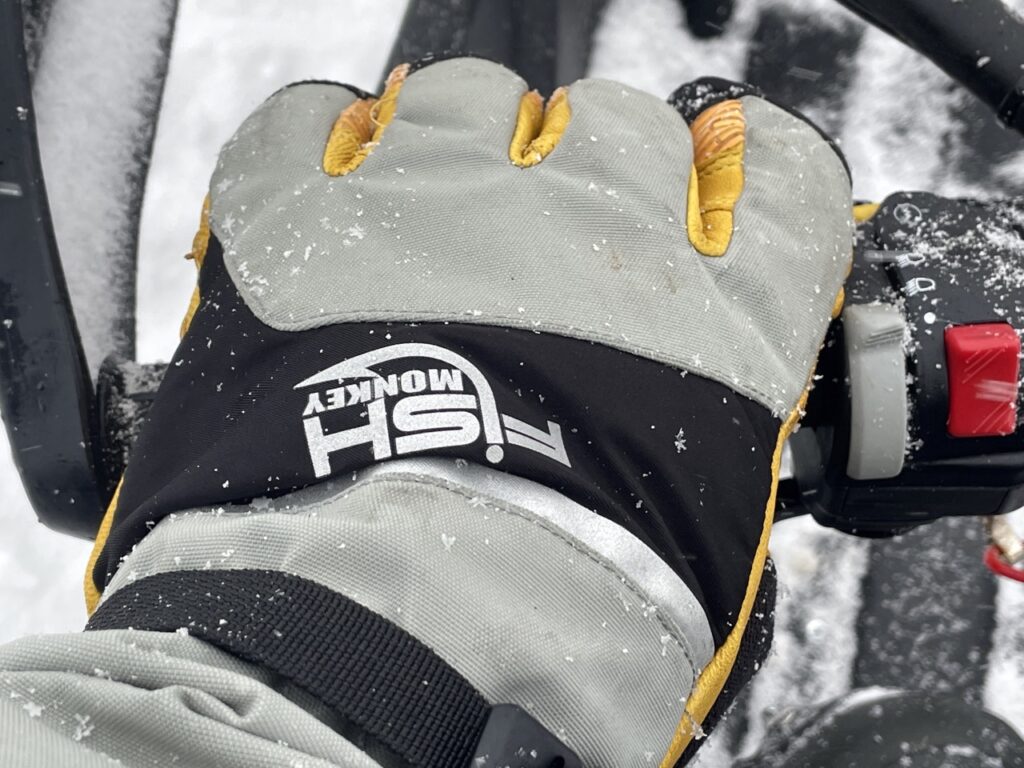
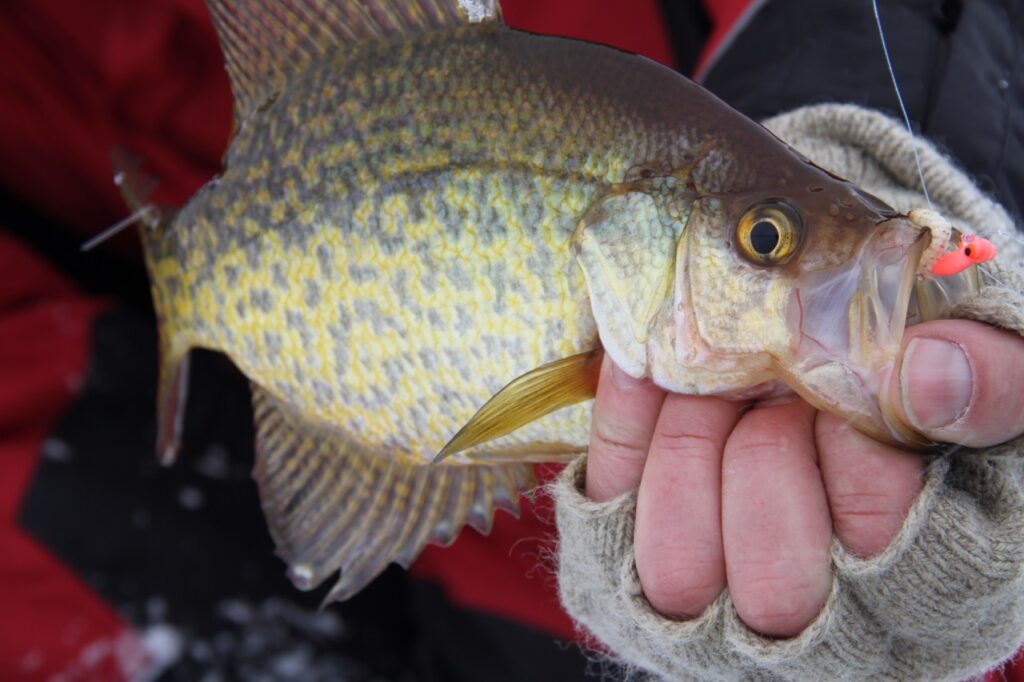
So, there are really two pairs of gloves or mitts that you need: first, a pair that you can wear when moving on the ice and exposed to the wind at higher speeds; and second, a pair that you can adequately fish in. The first is a no-brainer with plenty of options, but the second gets a bit more difficult and technical. Gloves can make it hard to operate a reel, feel bites through the rod, and do all the things you need to do, like tie knots, bait hooks, unhook fish, or snap a photo of a trophy.
To keep things really on the cheap, nothing beats a pair of old “chopper” light-brown leather mittens with MEGA warmers inside. You can pair this with wear a pair of fingerless wool gloves underneath and you have a system that’s hard to beat. Your hands are warm on the ATV when moving around, and when you need to perform some task that takes some dexterity, you simply slip your hands out and you’ve got your fingerless wool gloves on, which stay warm even when wet (although you want to avoid that, if possible).
Apparel manufacturers have similar systems, too, even with magnetic clasps that keep the ends of the mittens open to perform fishing tasks. Like Fish Monkey’s Tundra Mitten. We haven’t tried them but have heard from a few anglers that they work pretty well.
There are too many gloves and mittens to even mention here. Our advice: try some. For transport gloves/mitts, look for the bigger and bulkier models out there like CLAM’s new Renegade Glove. We’ve tried those this season and they’re quite warm. Same for Fish Monkey’s Yetti Gloves and Mitts which some of us here have worn since they came out. Striker, CLAM, and SIMMS Fishing make some good gloves and mitts, too. And old G.I. arctic mitts are a great find—the ones with the fur on the top side of the mitts and mitt extensions that cover well past the wrist.
But here’s the tip of the day. Want the ultimate glove for actually fishing in? We learned about there from a NAIFC competitor a couple years ago and after trying then, bought a few pairs so we wouldn’t lose them. Keep a pair in the truck, a pair at home, and a pair in your ice fishing crate.

At under $10 a pair, these latext coated insulated gloves are tough to beat. Worn by linemen working with high-voltage in cold weather—we’ve only found them available at once place in North Dakota—and couldn’t even find them on the Hand Armour website, but you can search around for similar options online and may even spot this style glove at your local hardware store. You can dip your hand in the minnow bucket and stay dry, pull a buddy’s fish out of the hole, actually fish in them, and stay warm in some pretty darn cold conditions. Seriously, check ‘em out.
Interested in our top 5 picks for the best ice fishing gloves? You can read more on that here.
8) HAND WARMERS
Especially when fishing with newbies and kids, the small investment in a bunch of hand, toe, or body warmer heat packs like HotHands or MEGA Warmers is always a good idea. They can be used in Chopper-style mittens, boots, and pretty much anywhere else you need some extra warmth. While there are a number of different brands out there, we’ve always had good luck with Grabber MEGA Warmers over generics.
9) HEATERS
For fishing outside in the extreme cold, it’s not a bad idea to set up a single or dual “sunflower” heater to spread out some warmth. While you don’t want to use sunflowers inside portable or hard-sided shacks, there are lots of portable propane heaters available at a reasonable cost.
Available in everything from 3,000/4,000 sports arena models to 18,000-20,000 BTU larger “Big Buddy” style heaters, you can find them at pretty much any hardware outlet.
Is there a big difference in the different brands? Not really, but some have features others don’t have.
For example, the Big Buddy accepts a lot of cool, garage-built accessories that can be found on the web—everything from griddles and grills to cast-iron stove style thermal-powered fans, and other “hacks.”
Also, some portable propane heaters have “off”, “low” and “high” settings. Others are actually thermostatic and allow adjusting the dial to exactly the temperature you’d like.
Of course, you want to size your portable propane heater to the size of your portable shack.
Most flip-overs can be kept pretty toasty with a 9,000 BTU middle-sized heater, whereas hubs benefit from the 18-20K BTU models. Old “Big Buddy” models used to have internal, battery-powered fan but new versions lack the feature, so you might want to get a thermal-powered cast-iron stove-style fan to position on the stove grill or a battery-powered fan to situate nearby and distribute the heat more efficiently.
Manufacturers include Mr. Heater Big and Lil’ Buddy, Heat Hog (with rotating heating element/grill surface to prevent water pooling up below the heater), DynaGlow, FlameKing, Dewalt, and others.

A good idea with any of these is to elevate them off the ice to prevent slush and water build-up from the heat. A simple milk-crate does the job perfectly. Also, you might consider buying a 5 lb. or 10 lb. propane tank if you’re planing longer days on the ice. Although you can learn to refill your own 1-pound cylinders off a 20-pound tank and there are now refillable systems and canisters coming onto the market, we’ve really taken to carrying one 5-pound tank, applicable heater hose/regulator, instead of multiple 1-pound canisters. You just have to be careful of preventing water from getting into and freezing in the hose/regulator.
Another increasingly popular option we are seeing is anglers opting to use for heat are portable diesel heaters for a drier heat source that results in less condensation in your shack keeping the windows fog-free. Keep in mind, however, that these require a battery to run and can be a bit more cumbersome to deal with and maintain.
*Caveat: Always keep your portable fishhouse vents open, even crack a door, to prevent carbon monoxide build-up. Carrying a dual thermostat/carbon dioxide detector has become standard procedure for a lot of anglers, especially if you’re doing any overnight fishing/camping with propane heat.
10) SHELTER
Lastly, if fishing from a portable, rule of thumb is to choose a flip-over or hub with the highest Denier insulation count you can find or afford, typically anywhere from 600 to 1200, depending on the size, brand, and model you prefer. Don’t forget to bank up the skirt with ice to prevent drafts and heat loss.

Good luck fishing out there and let’s all stay warm!


